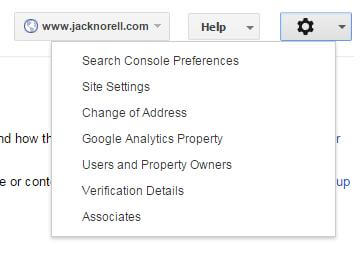In John Mueller’s webmaster hangout on 6 Nov 2015, I noticed a few comments on website moves which are interesting and go against standard recommendations for SEO.
In a site move (new domain name), Google considers 302s and 301s as equivalent.
“It’s not the case that 302s do something magical to block the flow of PageRank” – John Mueller
302s in a sitemove will pass PageRank as the redirects will be seen as a moved domain, not a temporary redirect. I’m assuming the requirement is also that the change of address (site move) is set in Google Search Console under site settings:

How long it takes for the new URLs to show rather than old ones is hard to say. John Mueller says it’s from hours to maybe a day.
“What will probably happen is that for some URLs on your site, it will take a little bit longer, for some it will go a lot faster.”
This is based on how Google crawls a website, indicating that the moved page needs to be recrawled after the change of address setting & redirects are live before the move takes effect.
The full move can take up to half a year, maybe longer.
If a site:oldsite.com advanced query is used, the indexed pages won’t drop out of the SERPs entirely until the site’s indexed pages are fully recrawled. Conversely, a site:newsite.com query will show a fast initial growth in indexed pages, and then a trickle of further URLs added over time.
Note that 301s are recommended by Google in their guidance for site moves.
“Set up server-side redirects (301-redirect directives) from your old URLs to the new ones. The Change of address tool won’t function without it.”
In other words, it’s still best practice to use 301s.
But if you’re not able to use 301 redirects, you can use 302 redirects in site moves without losing PageRank.
I don’t really understand why people would use a 302 instead of 301 – just run with what you know works and ensure a smooth transition, huh? :)
Clearly, 301 redirects should be used whenever possible for two reasons:
1 – The moved site will get organic traffic quicker on all search engines as the new pages are added to the index and old removed
2 – Rankings are protected as link value transfers more easily to the new site
Unfortunately, not everyone manages to get redirects set up correctly, and for us as consultants this means we may be able to work around it.
Not optimal, but if it’s an older migration you start working on, can possibly avoid a difficult ‘fight’ with hosting etc to change the redirect type.
Naturally, if the site did see significant traffic from search engines apart from Google, and not anymore after a site move, then getting those redirects changed will improve matters.
The other interesting part for me is that Google doesn’t see 302s as temporary over longer time periods, but will separate the actual vs. theoretical behaviour (from the response code standards).
And, that 302s will eventually carry page rank value within their algorithm. That’s intuitively correct and makes sense, but contrasts common SEO knowledge.
On a new site move, I’d be absolutely opposed to 302s as they won’t do as well as 301s.